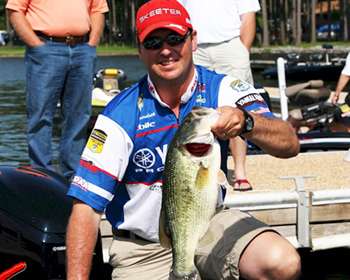
With a truck, a dual-axle boat trailer and a motor home, Texas pro Todd Faircloth has a lot invested in his tires. He has thousands of dollars worth of the round rubber road huggers, and he can't afford to have any of them let him down and leave him and his family stranded.
But the soft-spoken pro doesn't just depend on tires on the road — they're occasionally a key element of his fishing strategy. He's not typically referring to single tires that have washed into the drink due to high water conditions, but rather manmade reefs used to break current on a wide variety of lakes in his home region, including regular tournament stops like Lake Texoma on the Texas/Oklahoma border.
It's not simply a matter of finding one of these reefs and loading the livewell, however. When fish are on this pattern, sometimes just about any reef will do, but in most circumstances some reefs are clearly better than others.
"Just like a dock, the older the reef, the better," he advises. "They're going to have more algae and scum on them, which attracts the baitfish that attract the bass."
It's typically a situation that involves deep water. "The main thing you want to keep in mind when you're fishing tires or floating docks is that they're generally over 20- to 50-feet-deep water," he continues. "You'll see them around marinas or anywhere they're trying to break the waves."
But deep water doesn't necessarily mandate typical deep water presentations like football jigs, Carolina rigs, tailspinners or jigging spoons.
"The biggest key is to keep your bait high in the water column," Faircloth says. "You're not fishing the bottom. The fish are going to be suspended under these tires or reefs or whatever it is that's floating out there. They're generally going to be right underneath that structure. A lot of people cast and then let their baits go deep. They're actually fishing beneath the fish, when the fish are right below the tires. You want to fish your bait no deeper than 5 feet."
While it's possible to occasionally pitch or flip a bait into the center of a tire and pull out a bass, Faircloth says that most of his catches occur on the outside of the cover. He'll key on points, corners and any other irregularity, just as he would on a grassline or dropoff. His top lure choices in most situations are a swimming jig and a spinnerbait.
While the shade and the food sources resulting from the reefs will often hold fish year-round, Faircloth says his absolute favorite time to key on them is during the shad spawn, which typically occurs in May or June throughout the South and later in the year as you move north. That's when a white jig or a similarly colored spinnerbait gets the nod; the pattern "can be lights out," he notes.
And while some reefs are better than others, when you get a few good bites on one, odds are you can "rotate your tires" throughout the day en route to some monster catches. "If they're on that pattern, you can pretty much run it throughout the lake," Faircloth says.
(Provided exclusively to BASS Insider by Z3 Media)





